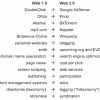Business Transformation Requires Transformational Leaders
Leadership and teaming skills are front and center in times of rapid change. Meet today’s constant disruption head on with expert guidance in leadership, business strategy, transformation, and innovation. Whether the disruption du jour is a digitally-driven upending of traditional business models, the pandemic-driven end to business as usual, or the change-driven challenge of staffing that meets your transformation plans—you’ll be prepared with cutting edge techniques and expert knowledge that enable strategic leadership.
Recently Published
Web 2.0
The human race has been defined in many ways: as "a featherless biped" (by Aristotle, who knew nothing of T. Rex or even the great apes), "homo sapiens," and "homo faber." It could equally well be classified as "homo garrulus," the species that loves to gossip, argue, and sound off -- especially on topics where there is unlikely to be a last word. Everyone is entitled to an opinion, and the Web has done a magnificent job of letting the broad masses publish theirs.
In the first installment of "Securing Cyberspace," we asked, "Is it time to rethink our strategy?" The answer was a resounding "yes." In next month's issue, our authors discuss a bevy of innovative ways we can protect our cyber infrastructure, from managing cyber risk through cyber insurance to reengineering the base protocols of TCP/IP.
In the first installment of "Securing Cyberspace," we asked, "Is it time to rethink our strategy?" The answer was a resounding "yes." In next month's issue, our authors discuss a bevy of innovative ways we can protect our cyber infrastructure, from managing cyber risk through cyber insurance to reengineering the base protocols of TCP/IP.
In the first installment of "Securing Cyberspace," we asked, "Is it time to rethink our strategy?" The answer was a resounding "yes." In next month's issue, our authors discuss a bevy of innovative ways we can protect our cyber infrastructure, from managing cyber risk through cyber insurance to reengineering the base protocols of TCP/IP.
In the first installment of "Securing Cyberspace," we asked, "Is it time to rethink our strategy?" The answer was a resounding "yes." In next month's issue, our authors discuss a bevy of innovative ways we can protect our cyber infrastructure, from managing cyber risk through cyber insurance to reengineering the base protocols of TCP/IP.
The management of knowledge is not new. Knowledge has been managed in organizations from time immemorial to ascertain that appropriate capabilities are available for people to perform requisite work competently and successfully. As a result, implicit knowledge management (KM) mechanisms were pursued by introducing practices such as master-apprentice traditions, educational programs, and so on.
Former Intel Chairman Andy Grove nicely described the link between strategic and operational risk, and the importance of managing the former by the latter, when he said, "People [employees] formulate strategy with their fingertips. Day in and day out they respond to things by virtue of the products they produce, the price concessions they make, the distribution channels they choose."
Vendor readiness for a security and privacy regime which meets the offshoring company's needs is a key vendor selection criteria as well as an operational imperative at the time the relationship with an offshore service provider is forged. As part of a comprehensive due diligence process on the cusp of signing a services contract, many organizations require a vendor to submit a security self-assessment.





